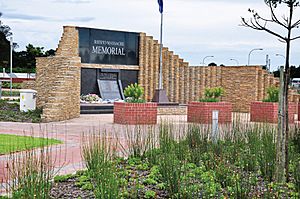Bhisho facts for kids
Quick facts for kids
Bhisho
Bisho
|
|
|---|---|

Bisho Massacre Memorial Site
|
|
| Country | South Africa |
| Province | Eastern Cape |
| Municipality | Buffalo City |
| Area | |
| • Total | 8.08 km2 (3.12 sq mi) |
| Elevation | 435 m (1,427 ft) |
| Population
(2011)
|
|
| • Total | 11,192 |
| • Density | 1,385.1/km2 (3,587.5/sq mi) |
| Racial makeup (2011) | |
| • Black African | 98.3% |
| • Coloured | 1.0% |
| • Indian/Asian | 0.2% |
| • White | 0.2% |
| • Other | 0.2% |
| First languages (2011) | |
| • Xhosa | 92.0% |
| • English | 4.0% |
| • Other | 4.1% |
| Time zone | UTC+2 (SAST) |
| Postal code (street) |
5605
|
| PO box |
5605
|
| Area code | 040 |
Bhisho, also spelled Bisho, is an important city in South Africa. It is the capital of the Eastern Cape province. This means many government offices are located here. You can find the Premier's office and the Provincial Legislature in Bhisho. The city is close to Qonce (about 3 kilometres away) and East London (about 70 kilometres away). Bhisho is part of the larger Buffalo City area.
Contents
History of Bhisho
What's in a Name? The Origin of Bhisho
The name Bhisho comes from the Xhosa language. It means "buffalo." The city is named after the Buffalo River, which flows through the area. A musician named Ben Tyazashe wrote a song about his home, which he called Bisho. Some people also say the name was chosen by a leader named Lennox Sebe. He wanted to include King William's Town in his area, but its Xhosa name, Qonce, was already in use.
Bhisho as Capital of Ciskei
For a while, Bhisho was the capital of a region called Ciskei. This was a "bantustan," a special area set up during Apartheid in South Africa. Ciskei was said to be independent in 1981, but most countries did not agree with this. In the early 1980s, under Lennox Sebe's leadership, Bhisho grew a lot.
The location of Bhisho was chosen carefully. It is just north of King William's Town. This spot was picked because the Ciskei government wanted to have a strong economic link to the nearby white community.
The Bisho Massacre: A Sad Day in History
On September 7, 1992, a very sad event happened in Bhisho. It is known as the Bisho massacre. Many people, about 80,000 to 100,000, marched to Bhisho. They wanted the Ciskei government to change and its leader, Brigadier Oupa Gqozo, to step down. Sadly, the Ciskei Defence Force opened fire. About 28 or 29 people were killed, and 100 were hurt. This event happened during a very important time. People were talking about how to create a new, democratic South Africa.
Bhisho After Apartheid
After the first democratic elections in South Africa in April 1994, Bhisho became part of South Africa again. This happened on August 12, 1994. In October 1994, the leader of the Eastern Cape, Raymond Mhlaba, announced that Bhisho would be the capital city of the Eastern Cape province. Bhisho was chosen because it had good buildings, was easy to reach by major roads, and had space to grow.
Later, in 2004, the official spelling of the city's name was changed from Bisho to Bhisho.
Bhisho Today: A Modern Capital
Today, Bhisho is a busy city with many important buildings. You can find the Eastern Cape government offices here, including the Premier's office. There is also a branch of the University of Fort Hare. Other key places include the Bhisho Hospital, the Bisho massacre Memorial, and the Bhisho Stadium. There's even a radio station called trufm.
Most people who work in Bhisho are public service workers. The city relies on nearby King William's Town and East London for many services. Bhisho is surrounded by several residential areas. These include Bhisho Central, Tyutyu North, Bhisho Gardens, Tyutyu Location/Central, Balasi, and Amatola View.
Climate in Bhisho
Bhisho has a climate that is mostly cool and semi-arid. This means it's often dry, but not extremely hot. It can also be close to a hot semi-arid climate or even a humid subtropical climate.
| Climate data for Bhisho | |||||||||||||
|---|---|---|---|---|---|---|---|---|---|---|---|---|---|
| Month | Jan | Feb | Mar | Apr | May | Jun | Jul | Aug | Sep | Oct | Nov | Dec | Year |
| Mean daily maximum °C (°F) | 26.4 (79.5) |
26.6 (79.9) |
25.5 (77.9) |
23.9 (75.0) |
22.1 (71.8) |
20.4 (68.7) |
20.0 (68.0) |
20.9 (69.6) |
21.7 (71.1) |
22.3 (72.1) |
23.5 (74.3) |
25.3 (77.5) |
23.2 (73.8) |
| Daily mean °C (°F) | 21.1 (70.0) |
21.3 (70.3) |
20.3 (68.5) |
18.2 (64.8) |
15.8 (60.4) |
13.9 (57.0) |
13.4 (56.1) |
14.2 (57.6) |
15.4 (59.7) |
16.7 (62.1) |
18.1 (64.6) |
19.8 (67.6) |
17.4 (63.2) |
| Mean daily minimum °C (°F) | 15.8 (60.4) |
16.1 (61.0) |
15.1 (59.2) |
12.5 (54.5) |
9.6 (49.3) |
7.4 (45.3) |
6.9 (44.4) |
7.5 (45.5) |
9.2 (48.6) |
11.2 (52.2) |
12.8 (55.0) |
14.4 (57.9) |
11.5 (52.8) |
| Average rainfall mm (inches) | 65 (2.6) |
71 (2.8) |
72 (2.8) |
43 (1.7) |
22 (0.9) |
19 (0.7) |
17 (0.7) |
28 (1.1) |
47 (1.9) |
80 (3.1) |
76 (3.0) |
70 (2.8) |
610 (24.1) |
| Source: Climate-Data.org | |||||||||||||
Notable People
- Ma Nala (born 1994) - a singer-songwriter
See also
 In Spanish: Bhisho para niños
In Spanish: Bhisho para niños




